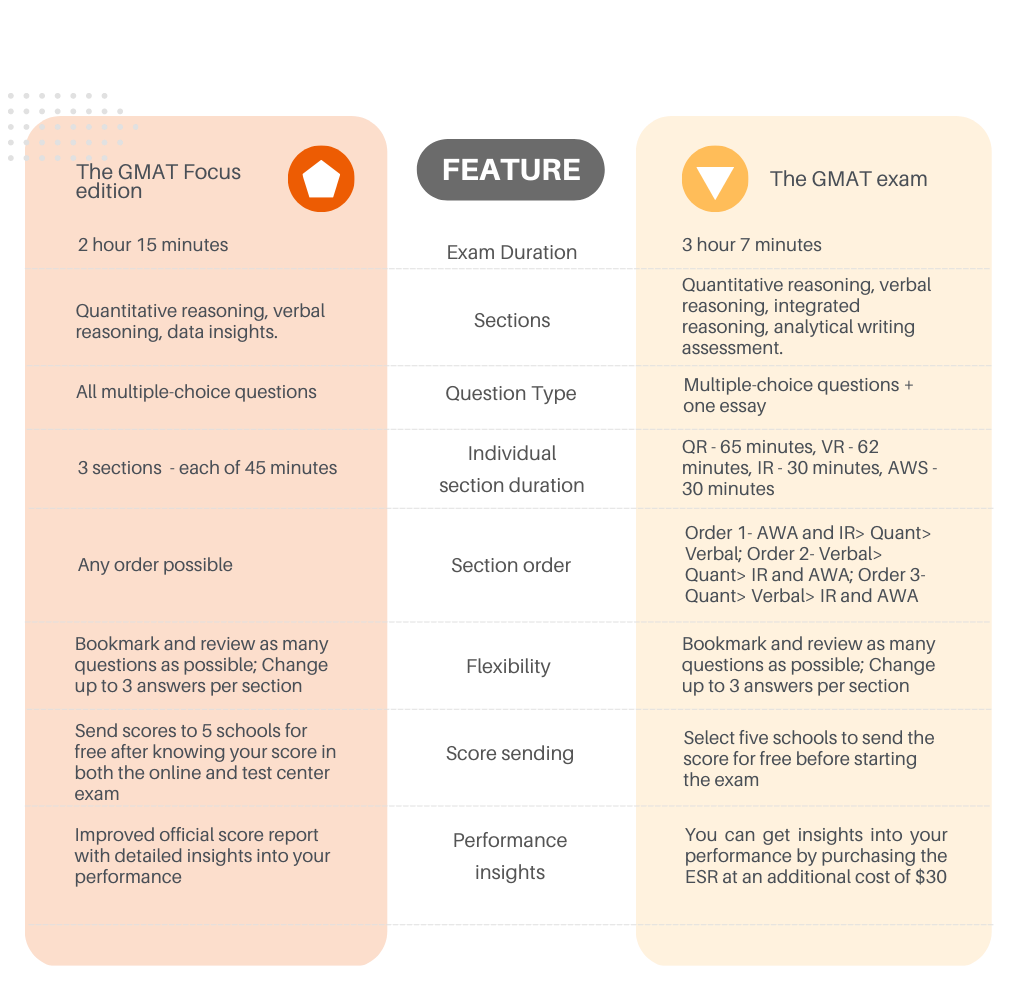The New GMAT Format will be introduced by the fourth quarter this year. For some time, both the current format of the GMAT exam and the new focus edition will be accessible to students to ensure a smooth transition to the new format. From later next year, the GMAT Focus edition will be the only format available to students.
The New GMAT test will be shorter (only 2 hours and 15 minutes), require less time to prepare, and give the students more flexibility. The students will also be able to mark and review their answers, and even change up to three of them in each section. The essay section has been dropped, and there are rumors that the Sentence Correction questions from the Verbal section and Geometry questions from the Quantitative section will also be removed. The Data Insights section, which will be one of the three 45-minute sections, will include questions similar to those typically tested on the Integrated Reasoning part. The other two sections will be the Verbal and Quantitative Sections.
These changes are extremely significant and have probably been implemented in the backdrop of the falling number of GMAT test takers. In the last five years, the number of GMAT test takers has dropped by almost 50% worldwide, with the most significant drop seen in the US itself. While there are other reasons for this drop in the number of test takers, most people believe it is due to many universities going test-optional, especially post-COVID. A study has been published showing how making tests optional has made campuses more diverse and accessible to students from underprivileged backgrounds.
In light of the changing contexts, it was imperative for the New GMAT format to introduce certain modifications that would both cater to students’ needs and make the text appear less daunting, without compromising on its standard and its ability to genuinely indicate how well a student would perform in business school. To evaluate whether the GMAT Focus Edition will boost the number of test-takers, let’s examine the changes it will bring. This allows for a smoother transition to the updated format, as both versions will be accessible for a period of time.
The forthcoming New GMAT will introduce several significant changes, including:
Duration: The test will have three 45-minute sections, making it 2 hours and 15 minutes long. Currently, the test is 3 hours and 7 minutes long, reducing the time by almost an hour.
Reduced Content: The exam will now require less time to prepare. The GMAT exam will have classroom-ready content.
Sections: The Analytical Writing Assessment section will be excluded, and all questions will now be multiple-choice. A new Data Insights section will be included, in addition to the Verbal and Quantitative sections.
Flexibility: Students can choose the section orders according to their preference. They can start with Verbal and then go to Quant and Data Insights or start with Data Insights and end with Verbal.
Review: Students will be able to bookmark and review as many questions they like. They will also be able to go back and change up to three responses per section.
Score sending: Students will have the option to select programs after receiving their scores. Furthermore, every Official Score report will display only one exam score, enabling the individual to decide whether or not to share previous scores with schools.
Insights: The Official Score Report will contain detailed performance insights.
So, will the New GMAT format benefit students?
Probably, here’s why:
Removing the AWA section will cut down on the mental exhaustion of writing an essay. However, since it wasn’t a part of the main score, it won’t reduce prep time significantly.
However, if the Sentence Correction section is indeed removed, then it will reduce preparation time by a lot. For the most part, the verbal section of the GMAT is a test of a student’s reading and critical thinking skills. The SC part also tests both, but it is rule-based, and students need to learn those rules and then use the learning in identifying meaning and grammar errors in sentences. If the SC section is taken out, then the time to prepare for the test will reduce.
The ability to review and change three answers per section will also be helpful for students. However, how that will change the adaptive nature of the test remains to be seen.
As international student numbers begin to bounce back from the pandemic, the United States is nearly back to the enrollment levels it had before the pandemic. Additionally, India has experienced a surge in students seeking higher education abroad, reaching a six-year peak of 750,365 students in 2022, according to the Hindustan Times. This increase in international students could impact the future direction of all standardized tests, including the GMAT.

Implications of Changes/Probable Changes
The New GMAT format could provide a psychological boost to test-takers. The reduction in test duration is one such change that is expected to be positively received.
However, it should be noted that the Verbal and Quantitative sections, the two sections that together contribute to the score out of 800, still require 2 hours and 7 minutes to complete. So, the real change in time is not that significant. However, a reduction in test preparation content will undoubtedly be a positive development, particularly for students with limited preparation time.
Many believe that the test will have a single score, although it hasn’t been officially confirmed yet. This New GMAT format would be extremely significant as it would guarantee that all the sections of the exam are accorded equal importance. Presently, Analytical Writing Assessment (AWA) and Integrated Reasoning (IR) sections are often overlooked by students because they are outside the main 800 score.
When the IR section was introduced in 2012, it was intended to differentiate business school aspirants by testing a crucial skill required in modern business education. However, since it is not a part of the main score, it probably could not achieve its objective. If the new Data Insights section is included in the main score, it would be a positive development, as it is considered an essential skill. It is expected to be an extension of IR.
If GMAT indeed drops Sentence Correction from the Verbal Ability section, it will be a major change. Removing AWA and the Sentence Correction questions will further distinguish GMAT from other English Language proficiency tests. While the decision to eliminate the AWA section has been largely accepted, it appears to contradict GMAT’s ultimate goal of increasing the focus on critical reasoning.
While other sections evaluate a student’s critical reasoning abilities, the AWA section was unique in evaluating their capacity to articulate their reasoning in their own words, a vital skill for business school graduates.
There is a major concern about the New GMAT test, particularly about how the algorithm will adjust after students change their answers. Since the test is adaptive, meaning the difficulty of the next few questions depend on the student’s performance in the previous question(s), there is confusion about how the algorithm will work in this scenario.
It’s still unclear if the test will still be scored out of 800. Despite these uncertainties, the New GMAT format has worked closely with stakeholders to implement necessary changes to become a more desirable option for both students and business schools. However, other factors that are determined by economic, cultural, and technological shifts such as the significance of standardized testing in the education system are much more difficult to control and may eventually lead to some form of creative destruction in the years ahead.
Get the best GMAT online coaching in India at EduAims. We offer comprehensive coaching and personalized guidance to help you excel in your GMAT exams. Join us to get the best guidance for GMAT and achieve your dream score.

